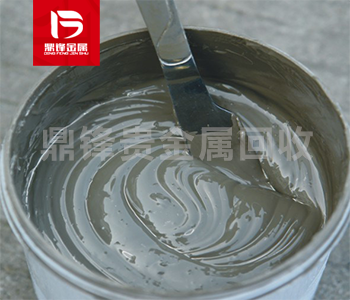
Palladium Paste Recycling
Palladium paste is made by mixing palladium powder with binder and solvent. Binders are usually made from materials that bind palladium powder together, while solvents are used to dissolve the binder and create a paste that can be applied to the surface. Once the paste is applied, it is heated to dry and harden. Adhesive is a material that helps paste adhere to the substrate and can be made of various types of polymers or resins. This solvent is used to dissolve the binder and promote the spread of the paste on the substrate. The choice of solvent depends on the type of adhesive used, the viscosity of the required paste, and specific application requirements. Some additives can be added to the formula to improve the performance of palladium slurry. For example, surfactants can be added to increase the wetting ability of the slurry and improve its adhesion performance. Antioxidants can also be added to protect palladium particles from oxidation and improve the stability of the paste.
- Parameter
- Related Questions and Answers
-
Name : Palladium Paste
-
Use : Conductive paste,Exhaust Catalysis
-
Application Areas : electronic industrial,auto industry
-
Appearance and properties : Grey paste
-
Settlement Method : On site payment
-
Recycling Type : Palladium recycling
-
Door-to-door recycling:worldwide
-
Customer service: Free content testing and door-to-door recycling
Palladium Acetate Recycling
Palladium acetate, also known as Palladium(II) acetate, is an organic acid salt compound of palladium, with the chemical formula Pd (CH3COO) 2. It is a colorless crystal that takes on a solid form at room temperature. Palladium acetate is soluble in organic solvents such as alcohols and ethers, but its solubility in water is relatively low., also known as Palladium(II) acetate, is an organic acid salt compound of palladium, with the chemical formula Pd (CH3COO) 2. It is a colorless crystal that takes on a solid form at room temperature. Palladium acetate is soluble in organic solvents such as alcohols and ethers, but its solubility in water is relatively low.
Search : Palladium Acetate RecyclingPalladium Wire Recycling
Palladium wire is a filamentous material made of high-purity palladium (such as palladium wire), which is widely used in industrial production due to its excellent physical properties and corrosion resistance.
Search : Palladium Wire RecyclingPalladium Sulfate Recycling
Palladium sulfate is a reddish brown palladium catalyst mainly used in electroplating and catalyst fields, as well as analytical reagents. Palladium sulfate has good catalytic activity and is generally used as a reagent, such as a debenzylation reagent. It is also a raw material for synthesizing and producing various palladium containing compounds and catalysts. A compound synthesized with palladium sulfate.
Search : Palladium Sulfate RecyclingPalladium Slag Recycling
Palladium slag is a byproduct or waste containing palladium element, usually generated during the extraction and processing of palladium metal. Palladium slag refers to the residue, waste or waste generated during the production or use of palladium metal, which contains compounds or mixtures of palladium elements.
Search : Palladium Slag RecyclingProduct Details
Palladium paste is made by mixing palladium powder with binder and solvent. Binders are usually made from materials that bind palladium powder together, while solvents are used to dissolve the binder and create a paste that can be applied to the surface. Once the paste is applied, it is heated to dry and harden. Adhesive is a material that helps paste adhere to the substrate and can be made of various types of polymers or resins. This solvent is used to dissolve the binder and promote the spread of the paste on the substrate. The choice of solvent depends on the type of adhesive used, the viscosity of the required paste, and specific application requirements. Some additives can be added to the formula to improve the performance of palladium slurry. For example, surfactants can be added to increase the wetting ability of the slurry and improve its adhesion performance. Antioxidants can also be added to protect palladium particles from oxidation and improve the stability of the paste.
Palladium paste can be applied to the substrate using a variety of techniques, including screen printing, syringe dispensing, or spray. After application, the paste is usually cured by high-temperature heating to evaporate the solvent and melt the palladium particles together. This process produces a stable conductive component that can withstand long-term exposure to harsh environments. Palladium paste is a key component in many electronic and industrial applications, and its content may vary depending on the intended use. Palladium metal powder is the main active ingredient, usually combined with binders, solvents, and other additives to improve its performance. This slurry can be applied and cured using various techniques to produce stable and durable conductive components.
Waste palladium paste is one of the recycling sources of palladium containing waste, including colloidal palladium recycling, palladium mud recycling, palladium water recycling, palladium resin recycling, palladium asbestos recycling, palladium catalyst recycling, etc. If you have any demand for palladium containing waste recycling, please call our 24-hour service hotline. Dingfeng Precious Metal Recycling and Refining Factory has independent recycling and refining factories without intermediaries to earn price differences. Our professional technical team and customer service personnel provide one-on-one services to ensure customer privacy during the recycling process.

